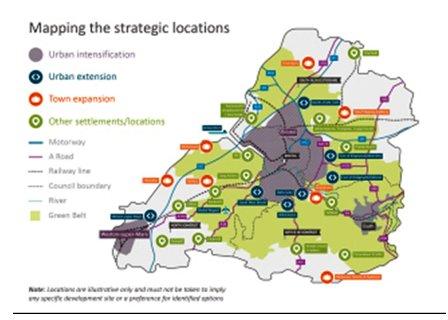The Society has commented on the Issues and Options consultation for the West of England sub-region’s Joint Spatial Plan and Joint Transport Study, which set out possible ways forward for the period to 2036 in the context of a projected housing need of 88,000 homes. This is a summary of our comments.
Joint Spatial Plan (JSP)
Scenarios: Looking at the five possible ‘scenarios’ for planning where new housing should go, no single scenario is likely to provide the additional accommodation needed. The Society suggests that scenarios 2 (Bristol-focused), 3 (Transport-focused) and 4 (other towns) should in some combination determine the choice of location of new development.
Green belt: We are in favour of a review of the green belt. When an 18% increase in housing is required and the green belt accounts for 48% of the plan area, it is unrealistic to hold unquestioningly to the existing green belt area. The countryside at the outer boundaries of the green belt does not necessarily deserve more protection than land just beyond. We must not rule out possible urban extensions for Bristol, as long as green ‘wedges’ are retained to link up with the existing green infrastructure in Bristol.
Urban intensification: in principle we are in favour of urban intensification in Bristol as part of the solution, where it can be achieved without damaging essential green infrastructure, because it makes use of existing transport infrastructure and services, and leads to shorter journeys. But it is difficult to do. Bristol Council should develop a strategy for pursuing intensification in certain locations, and follow through with masterplanning, funding and new delivery mechanisms, in order to unlock the full potential of the existing urban area.
Quality of new development: The West of England local planning authorities should adopt policies to ensure that new developments encourage active travel, and policies to discourage volume housebuilders’ large low-density developments, which are wasteful of land, have poor connectivity, and produce low volumes of affordable housing. There are plenty of examples of cities on the continent that demonstrate how higher density can be designed well.
Sub-regional working: whilst the four councils have a legal ‘duty to co-operate’, we are concerned that the final JSP will be influenced by each council’s parochial interest, particularly when three of the Local Authorities declare in the introduction to the JSP that the green belt should not be reviewed, and ‘Protection of the green belt’ is the first in the list of spatial options. It is difficult to see how a coherent sub-regional strategy will emerge when there is such fundamental disagreement between the participants.
Joint Transport Study (JTS)
Building roads vs managing traffic volumes. It is now an axiom of transport planning that new roads attract more traffic, which soon nullifies the ‘solution’ of the road improvement. However, there seems to be resignation in the JTS to building more roads. More emphasis should be given to possible behavioural changes through demand management, for instance to reduce the number of vehicles coming into Bristol city centre, so as to tackle air quality and make the place more pedestrian-friendly.
Large engineering projects vs smaller proposals and behavioural changes. The JTS concentrates on large capital projects at the expense of smaller proposals that would cumulatively deliver a sounder cost/benefit to more people at more locations, recognising the dispersed nature of travel journeys.
Transport mode hierarchy. The JTS seems to make no mention of the transport hierarchy which is an essential part of transport policy, enshrined in the existing Joint Local Transport Plan. The schemes proposed by the JTS give good weight to public transport, but not enough to cycling and walking (where walking includes walking to and from public transport). Walking and cycling should retain their position at the top of the transport hierarchy when developing schemes.
The structure of the consultation: we have concerns about the structure of the consultation. The JTS jumps straight from principles to 13 possible ‘scheme concept’ packages. Having identified key issues of dispersed and complex trip patterns, car dependency and congestion, and network resilience, there should be an analysis of alternative ways of addressing these issues. The JTS is centred too much on schemes, not enough on strategies, based on spatial analysis.
The full consultation responses may be found through these links: Joint Spatial Plan [PDF 291KB] and Joint Transport Study [PDF 308KB].
Alan Morris

